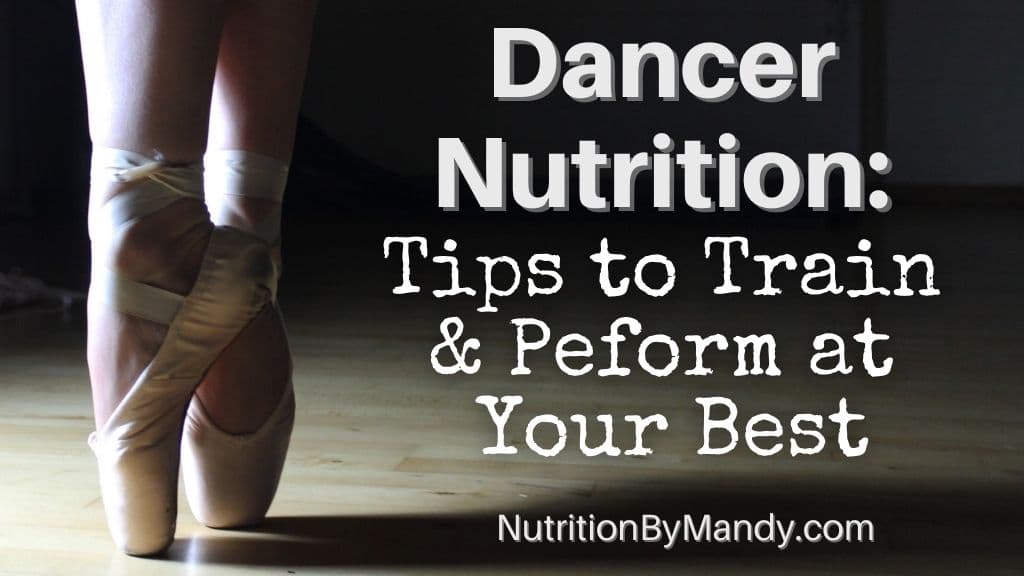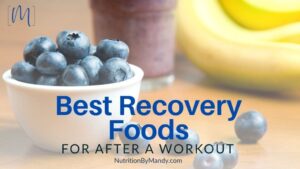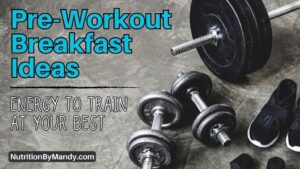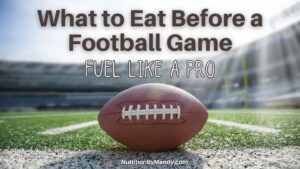Last Updated on March 23, 2025 by Mandy Tyler, M.Ed., RD, CSSD, LD
Dancer Nutrition: Tips to Train and Perform at Your Best
It is important dancers are equipped with knowledge on the best nutrition plan to support their training and performance needs.
Let’s take a look at key nutrients dancers should include in their meal plan. Then we will look at specific nutrition strategies to fuel dancers before, during, and after dance classes and performances.
Plan Ahead to Meet Your Dance Nutrition Needs
With busy dance class and performance schedules, it is important dancers take time to plan ahead to meet their nutrition needs.
Having the right foods available at the right time to support your activity is a key sports nutrition principle. Dancers should consider taking time on the weekend to meal prep for the upcoming week.
This can include simple ingredient prep tasks such as:
- Chopping fresh fruits and vegetables
- Preparing protein overnight oats for a quick breakfast
- Packing healthy snacks to take with you to dance class
- Hard-boiling eggs to add to a grab-and-go lunch
- Planning ahead for quick weeknight dinners
Dancer Nutrition: Carbohydrates for Energy
Dancers should include carbohydrate-rich foods at the foundation of their meal plan. Carbohydrates provide dancers with the optimal source of energy to train and perform at their best.
Dancers can add carbohydrates to their diets from a variety of food groups, including:
- Grains – Bread, pasta, rice, oatmeal, cereal
- Starchy vegetables – Potatoes, sweet potatoes, winter squash, corn, peas, beans, legumes
- Fruit – Fresh, frozen, dried, canned in natural juices, applesauce
- Dairy – Milk and yogurt
In addition to providing energy, whole grain carbohydrates, fruits, vegetables, beans, and legumes also contain fiber. Fiber is an important part of a well-balanced diet and is associated with many health benefits.

Importance of Protein for Dancers
Protein is an important nutrient for dancers for dancers, as it supports the building and maintenance of lean muscle mass.
Protein also has many other important functions in the body including: making enzymes and hormones that regulate body processes, producing antibodies that support immune health, transporting oxygen, and supporting cell repair (1).
Dancer Nutrition: Spread Protein Throughout the Day
When it comes to protein, dancers should aim to spread their protein intake throughout the day with several meals and snacks. It is recommended for individuals to eat ~0.25-0.3 grams of protein per kg of body weight at each eating occasion (2, 3).
In general, I encourage dancers to aim to enjoy between 20-30 grams of protein with their meals and snacks.
Sources of Lean Protein
There are a variety of ways dancers can enjoy protein throughout the day. Here are several ideas:
- Greek yogurt
- High-protein milk
- Hard-boiled eggs
- Low-fat cheese, cheese sticks, cottage cheese
- Poultry, seafood, pork, lean red meat
- Deli meat – Turkey, chicken, roast beef, ham
- Tuna and salmon canned in water
- Beef or turkey jerky
Plant-Based Sources of Protein
Dancers who are following a vegetarian or vegan diet can still meet their protein needs through food sources, such as beans, legumes, soy, nuts, and seeds.
However, careful planning of plant-based meals is important to ensure dancers consume adequate protein and essential nutrients in their overall sports nutrition meal plan.
Here are several ideas for plant-based proteins to include in your sports nutrition meal plan.
- Quinoa
- Soy protein – Edamame, tofu, tempeh
- Seitan
- Beans and legumes
- Nuts and nut butters
- Seeds and seed butters
For additional plant-based snack ideas, check out my blog: High-Protein Vegan Snacks for Athletes.
Dancer Nutrition: Choose Healthy Fats
Healthy, unsaturated fats are an important part of a sports nutrition meal plan for dancers. Dietary fats have many essential roles in the body.
Fat is necessary for the absorption, transportation, and storage of fat-soluble vitamins (Vitamins A, D, E, K). Fat also helps provide protection for our internal organs.
Sources of healthy, unsaturated fats dancers can include in their sports nutrition meal plan include:
- Avocados
- Nuts and nut butters
- Seeds
- Olives and olive oil
- Cold-water fatty fish
- Liquid, plant-based oils: Canola, sesame, safflower, peanut
Omega-3 Fatty Acids
Omega-3 fatty acids are considered to be essential fatty acids because the body cannot produce them itself.
These essential fatty acids have many important roles, such as supporting optimal brain health, cardiovascular function, and working to help reduce inflammation in the body (4).
Cold-water fatty fish, such as salmon, tuna, mackerel, herring, and sardines, provide an excellent source of omega-3 fatty acids.
Dancers can benefit from including several servings of fish rich in omega-3 fatty acids in their meal plan throughout the week.

Hydration for Dancers
Hydration is important for dancers to support both health and optimal performance. Dehydration can negatively impact performance and increases the risk of developing a heat illness (5).
To help meet your hydration needs, consider carrying a refillable water bottle with you to sip on throughout the day. Prior to the start of your dance class, refill the water bottle so it is ready for the workout session.
Dancer Nutrition Strategies
Now let’s take a look at specific nutrition strategies to fuel dancers before, during, and after dance classes and performances.
Planning Your Pre-Dance Meal
When determining what to eat before your dance class or performance, the timing of the meal matters.
In general, the less time dancers have prior to the start of the activity, the smaller the pre-workout meal should be.
When possible, I encourage dancers to schedule their pre-workout meal to be eaten 3-4 hours prior to the dance session.
What to Eat Before Dance
A dancer’s pre-workout meal should include a good source of carbohydrates and a moderate amount of protein. With the meal, dancers should aim to drink ~2 cups of fluid to help ensure they start their dance session in an optimally hydrated state.
Pre-workout meal ideas for dancers include:
- Oatmeal with berries and walnuts, banana, low-fat milk
- Bagel with sliced avocado, hard-boiled eggs, 100% fruit juice
- Pasta with grilled chicken, vegetables, and marinara sauce, breadstick, water
- Turkey sub sandwich, pretzels, apple slices, sports drink
Eating the pre-workout meal several hours before the dance session allows time for dancers to digest the meal prior to activity. It also allows dancers time to go to the restroom before their workout if needed.
If dancers have less time before their workout (1-2 hours), they should focus on consuming carbohydrate-rich snacks for energy. Eating foods that are high in fat, fiber, and/or protein too close to the competition may cause GI distress during the activity (3).
Dancers should continue hydrating in the hour leading up to activity, aiming to drink around 8 oz of fluid during this time period.

Dancer Nutrition: Afterschool Dance Classes
If dancers are planning to head straight to dance class from school, they should make sure they pack afterschool snacks. Prior to dance, it is best to focus on high-carbohydrate snacks which provide dancers with the energy needed to train at their best.
Easy ideas for snacks dancers can pack in their backpacks include:
- Fresh and dried fruit
- Applesauce squeeze packs
- Granola bars, fig bars, breakfast bars
- Mini bagels, dry breakfast cereal
- Pretzels, pita chips, animal crackers, graham crackers
Snacks Between Dance Classes
Dancers can enjoy these same high-carbohydrate snacks when they have breaks between dance classes.
Dancers should remember that as they exercise, their body uses their carbohydrate stores for energy. Consuming carbohydrates, either from a snack or a sports drink, can help supplement their body’s stores and provide additional energy for the dance session (3).
The carbohydrates you consume during the break can provide valuable energy for your next dance class.

Dancer Nutrition: Hydration During Dance Classes and Performances
During activity, dancers sweat in order to remove heat from their bodies. It is important to recognize that when dancers sweat, they lose both fluid and electrolytes. The main electrolyte lost in sweat is sodium.
Thus, when focusing on staying hydrated, it is important for dancers to consume both fluid and sodium.
Individuals vary greatly in the amount of sweat lost during activity. However, as a general rule, dancers should aim to drink ~3-8 ounces of fluid every 15-20 minutes of activity (3, 5).
Drinking a big gulp of water or sports drink is equivalent to approximately 1 ounce of fluid. Therefore, dancers should aim to drink several big gulps from their water bottle during each break.
When participating in multiple classes throughout the day, a sports drink can help dancers with replacing fluids and electrolytes. In addition, the carbohydrates contained within the sports drink can provide dancers with energy to continue training or performing at their best.
Recovery Nutrition for Dancers
When participating in a dance intensive involving multiple days of classes and training, it is important to make recovery nutrition a priority.
The three goals of recovery nutrition for dancers are to consume the following:
- Fluid and Electrolytes – Rehydrate to replace sweat losses
- Carbohydrates – Refill the energy (carbohydrate) stores used during the activity
- Protein – Buildand repair lean muscle mass
Dancer Nutrition: Post-Workout Meal and Snack Ideas
Consider packing snacks in your dance bag you can enjoy at the end of the day. This is particularly important if your next meal will not be for several hours.
Example snacks may include:
- Peanut butter and jelly sandwich with a banana
- Trail mix made with dry cereal, pretzels, dried fruit, nuts and a sports drink
- Low-fat chocolate milk and granola bars
- Greek yogurt, berries, and granola
- Fruit smoothie
Aim to follow your recovery nutrition snack with a well-balanced dinner containing carbohydrates, lean protein, healthy fats, and fluids.
Ideas for post-dance meals include:
- Burrito bowl with rice, chicken, black beans, corn salsa, guacamole and a sports drink
- Grilled salmon, sweet potato, steamed broccoli, dinner rolls, and 100% fruit juice
- Pasta with lean meat sauce, salad, breadsticks, low-fat milk
In addition to nutrition, dancers should focus on getting quality sleep to support their recovery needs. During sleep the body heals and repairs, which is essential for muscle growth and recovery from exercise sessions.
Even with busy dance and school schedules, it is important for dancers to make sleep a priority.

Dancer Nutrition: Fueled for Performance
Similar to practicing your dance choreography, take time to practice your nutrition strategies prior to a dance performance. Each dancer is unique; thus, it is important to figure out what type of foods and beverages help you perform at your best.
Dancers should remember to make recovery nutrition a priority, especially during periods when they have multiple performances close together.
Going into their performances with a well-practiced sports nutrition plan can provide dancers with confidence that they are fueled to perform at their best.
Supporting the Nutrition Needs of Dancers
Elite dancers often expend a high number of calories through performance rehearsals, dance classes, conditioning, daily activities, and energy needed for normal health, growth, and development.
When daily caloric expenditure from these activities exceeds dietary intake of calories from foods and beverages an imbalance occurs. This results in low energy availability to support a dancer’s health and performance.
In sport, we refer to this imbalance of calories as Relative Energy Deficiency in Sport or REDs (6). Recently the understanding of REDs has been expanded to address similar concerns in dancers, referred to as Relative Energy Deficiency in Dance or RED-D (7).
What is Relative Energy Deficiency in in Dance (RED-D)
RED-D is associated with a syndrome of health and performance concerns resulting from low energy availability.
Underfueling can negatively impact bone health, menstrual function, immune health, cardiovascular function, protein synthesis, metabolic rate, and GI function. In addition, it can disrupt normal growth and development and have negative impacts on psychological health (6, 7).
Dance performance may also be impacted by the caloric imbalance – resulting in decreased muscle strength, endurance performance, and response to training. Dancers with low energy availability are at an increased risk for injury and illness (6, 7).
It is critical for dancers to ensure they have an adequate intake of calories to support their health, daily activity, and performance needs.

Disordered Eating in Dancers
It is important to note that in some situations, disordered eating patterns are also contributing to the calorie imbalance.
Disordered eating behaviors exist on a continuum ranging from occasional unhealthy eating and exercise behaviors to clinically diagnosed eating disorders (3).
Dancers anywhere along the continuum displaying disordered eating behaviors can benefit from meeting with a sports dietitian nutritionist. A sports dietitian is a key part of the treatment team, working alongside a mental health professional to address the specific health and nutrition concerns of the athlete.
Dancer Nutrition: Tips to Train and Perform at Your Best
You are now set with a variety of ideas to help you meet your nutrition needs as a dancer. Remember to plan ahead and use the dancer nutrition strategies shared to help you train and perform at your best.
For additional sports nutrition tips, check out my blog with grab-and-go lunch ideas for athletes.
Join the Nutrition By Mandy Email List & Get a Free Athlete’s Grocery List
Click HERE to join the Nutrition By Mandy e-mail list. When you join you will receive a free athlete’s grocery list to print and take with you to the store.
About the Author
Mandy Tyler is a Sports Dietitian Nutritionist in the San Antonio, TX area. She is a Registered and Licensed Dietitian, a Board-Certified Specialist in Sports Dietetics, a Licensed Athletic Trainer, and is a Certified Exercise Physiologist through the American College of Sports Medicine. Mandy has experience working with athletes at the high school, collegiate, and professional levels. She believes the key to reaching one’s full potential, both in everyday life and in sports performance, relies on a healthy nutritional foundation.





